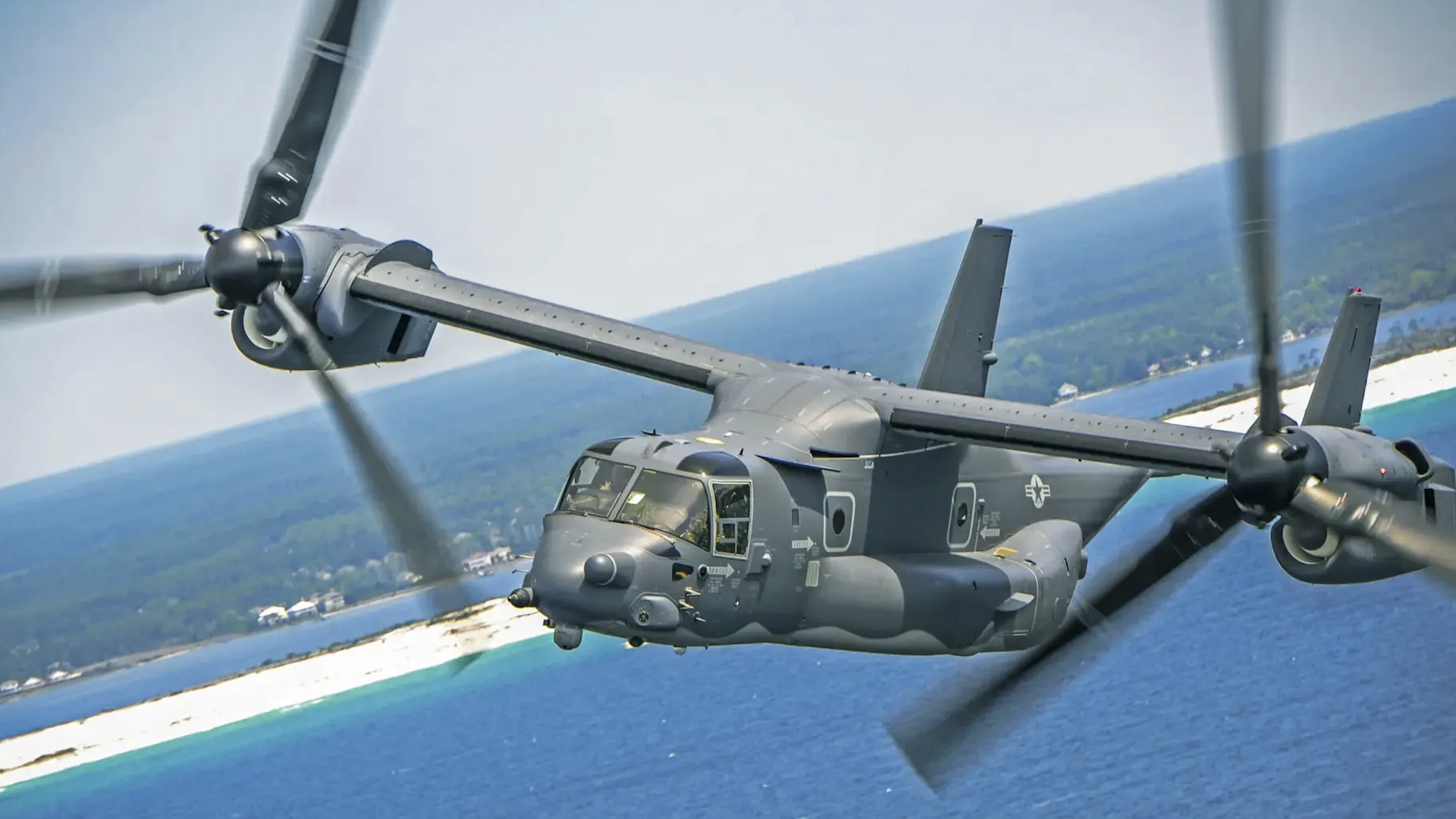A mishap on an Air Force Special Operations Command (AFSOC) CV-22 Osprey tilt-rotor aircraft last month has led to an operational pause for the U.S. military’s fleet of the aircraft, which are operated by Marines and Navy as well. Marines are pausing all non-essential flights.
The Osprey was conducting a training mission at Cannon Air Force Base on Nov. 20 when it experienced “a material failure” that forced the crew of four to make an emergency landing, AFSOC spokesperson Lt. Col. Becky Heyse told The War Zone Monday morning. There were no known injuries or external damage to the aircraft, she added.

As they were flying, the crew started to “get indications in the cockpit to land as soon as possible,” Heyse explained. “The incident is under investigation, but the initial indications are that this was another material failure. We believe it was different than what occurred last year.”
Heyse was referring to the Nov. 29, 2023 mishap that killed all eight aboard a CV-22 operating off the coast of Japan. A subsequent investigation found that the crash was caused by “a catastrophic failure of one of the tiltrotor’s gearboxes” and “decisions made by the pilot.”
From our story about the investigation:
“After an analysis of the parts of the left-hand [proprotor] PRGB that could be recovered, it was determined that the catastrophic failure in this instance was ‘most likely initiated by a crack in one of the high-speed pinion gears and fatigue cracking of the associated pinion gear’s bearing cage. Additionally, at least one piece of the failed high-speed planetary pinion wedged in the high-speed carrier assembly, grinding against the high-speed sun gear’s teeth until finally removed.’”
In that flight, the pilot and crew did not “plan for, deliberate, or even discuss” closer suitable landing options after they received the chip burn warning about the left-hand [proprotor gearbox] PRGB, according to the Accident Investigation Board report. The AIB described it as an “insufficient sense of urgency throughout the entire mishap sequence, beginning with the first PRGB cockpit advisory approximately 49 minutes prior to aircraft impact.”
Heyse said it was too early to offer any details about the new material failure.

The entire fleet of U.S. Ospreys was finally cleared to fly again in March, which you can read more about here. Now they are grounded again.
“Out of an abundance of caution, NAVAIR recommended an operational pause for all V-22 Osprey variants Dec. 6, 2024,” said spokesman Neil Lobeda. “This decision comes following a recent precautionary landing of a CV-22. There were no injuries to the crew. The safety of our V-22 aircrew is our top priority. We are committed to ensuring our Sailors, Airmen and Marines are able to successfully complete their missions and return home safely.”
All three services have paused V-22 operations.
“We have a pause right now to our flight training operations, based on the recommendation from NAVIAR,” Heyse told us.

“In response to a NAVAIR recommendation on the V-22 Osprey fleet, the Marine Corps has decided to implement a 96-hour operational pause for non-essential flight operations starting on December 6, 2024,” a USMC spokesman said in a statement. “This decision underscores our unwavering commitment to the safety of our personnel and the reliability of our aviation platforms. This pause will give us time to determine if any additional measures are necessary to ensure the continued safety and effectiveness of this critical capability. The Marine Corps remains confident in the safety and effectiveness of the MV-22.”
Since the Osprey first flew in 1989, more than 400 V-22s have been delivered to Marines, Air Force, and Navy, as well as the Japan Self-Defense Forces (JSDF) — the latter being the only non-U.S. operator of the type. Marines are by far the largest operator of the Osprey, with some 348 MV-22Bs spread across 17 squadrons. AFSOC has about 50 and the Navy has 36, including one test aircraft.

“On Dec. 9, 2024, Commander, Naval Air Forces directed an operational pause for all U.S. Navy CMV-22B Ospreys following the recommendation by Naval Air Systems Command,” Navy Cmdr. Beth Teach said in a statement.

The lessons learned from the fatal 2023 crash contributed to the Cannon crew’s ability to land safely, Heyse told us.
AFSOC “updated all procedures after the crash last year,” she said. “The return to fly part was an increased focus on training and simulators. The initial indicators show that is why they were able to safely land, based on those flight control measures and training taken. We will learn more as the investigation continues.
After the November 2023 mishap, all V-22s were limited to flying within 30 minutes of a suitable divert airfield. In particular, this limits the CMV-22’s ability to operate from aircraft carriers. The main function of CMV-22B Osprey tilt-rotor aircraft is to perform aircraft carrier onboard delivery (COD).
Marine Ospreys from HMX-1 also support presidential airlift mission, primarily carrying the press pool, aids, and Secret Service counter-assault team around, which you can read more about here.
This is the latest mishap in a long string of problems for the Ospreys. Overall, the Bell-Boeing tiltrotor has had a checkered history, punctuated by numerous fatal crashes since its first flight in 1989, though U.S. military officials regularly point to a broadly improving track record in the past few decades.
For now, we will have to wait and see how long this latest pause lasts, which material part failed, and whether other variants are experiencing the same problem.
Contact the author: howard@thewarzone.com
